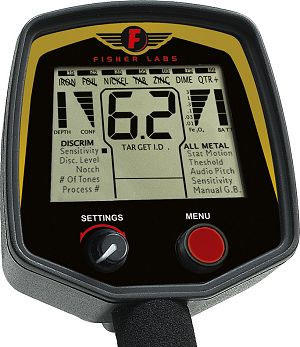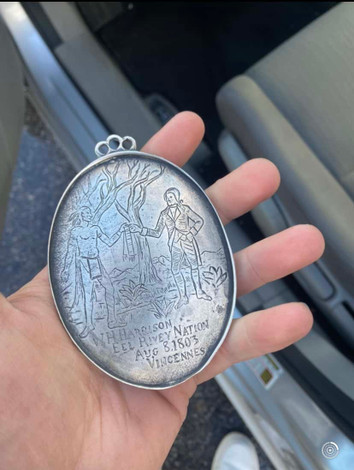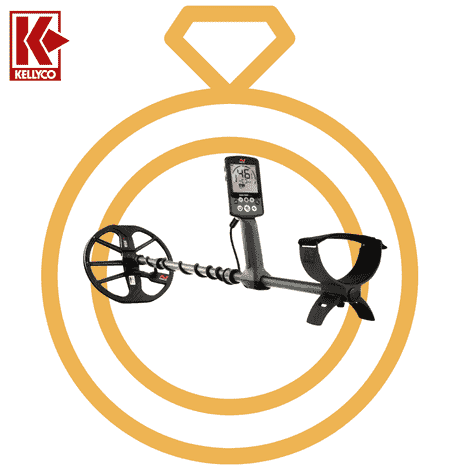The Fisher F75 metal detector is a high-performance, multipurpose device designed for serious relic hunters, coin shooters, and professional gold prospectors. Featuring a robust, lightweight design and advanced technology, the F75 offers exceptional sensitivity and depth detection. Its intuitive user interface is highlighted by a large LCD screen that provides vital information, such as target identification, depth, and ground mineralization. With its ergonomic design, the F75 ensures user comfort during extended use, allowing enthusiasts to explore various terrains with ease and precision.
The F75 comes equipped with a waterproof 11-inch Bi-Axial search coil, ideal for searching in diverse environments, including high-EMI areas. The metal detector boasts multiple search modes, including discrimination, static all-metal, and motion all-metal, catering to various detecting needs. Additionally, the F75 features trigger-actuated FASTGRAB™ ground balancing with manual override, adjustable audio pitch, and an innovative Digital Shielding Technology (DST) mode to suppress EMI effectively. The detector's notch and discrimination controls, combined with the FeTone® settings, enable users to filter out unwanted targets and focus on valuable finds.
Designed and engineered by Fisher Labs, the F75 is built to endure outdoor conditions while maintaining high performance. The device is powered by four AA alkaline batteries, offering up to 40 hours of continuous use. The adjustable armrest and durable foam elastomer grip provide added comfort, making it easier for users to maneuver the detector. With its advanced features and user-friendly design, the Fisher F75 metal detector stands out as a top choice for both novice and experienced detectorists looking to uncover hidden treasures beneath the surface.
Quick Start
Use Your F75 Right Out of The Box.
- Assemble the detector
- Install batteries

- Turn the knob located under the armrest, fully clockwise. This turns the detector on and sets audio volume to maximum
- Go outside. Toss a coin on the ground and sweep the search coil back and forth over it a few times to see how the detector responds
- You are now ready to search
High Performance
The F75 is a multi-purpose high-performance computerized metal detector. It has the high sensitivity and ground balancing control needed for professional gold prospecting, the discrimination responsiveness needed for serious relic hunting under difficult conditions, and visual target ID considered essential in searching for coins. The F75 operates at 13 kHz for good sensitivity to gold nuggets and jewelry as well as to coins. The F75 comes with an 11" elliptical Double D search coil for maximum detection depth in mineralized soils.
User Comfort
The F75 is among the lightest and best balanced of all high-performance metal detectors, so you can hold and swing it almost effortlessly. The arm rest position is adjustable to fit your arm. The grip is durable high-friction foam elastomer, comfortable in any kind of weather. The controls are conveniently located and easy to learn how to use. Locking collars on the tubes eliminate rattling.
 Easy-to-Use & Informative Interface
Easy-to-Use & Informative Interface
The entire menu is always visible on the LCD display. The LCD display indicates the electrical signature (Target ID) of the detected metal object. The display provides continuous information on battery condition and on ground mineralization, which affects detection depth. Help messages are automatically displayed on the bottom of the display when necessary.
Low Operating Cost
The F75 is powered by four AA alkaline batteries, which will typically last for more than 30 hours of use before needing replacement.
Designed by Many of the Industry's Most Talented Engineers
The lead engineers on the F75 design team were John Gardiner and David Johnson. David Johnson's previous Fisher design credits include the CZ-platform, the Gold Bug-series, most of the 1200-series, Impulse Underwater Detector, CZ-20 Underwater Detector, FX3 magnetometer, the Gemini 2-box locator, the XLT-16 Acoustical Leak Detector, and the XLG-80 Ultrasonic Leak Detector. David was supported by fellow electrical engineers Jorge Corral, Dimitar Gargov, and Mark Krieger. The mechanical design was a collaboration among David Johnson, Brad Fulghum, John Griffin, and Tom Walsh.









 Easy-to-Use & Informative Interface
Easy-to-Use & Informative Interface







